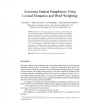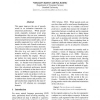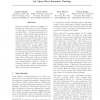297 search results - page 47 / 60 » Smoothing and Word Sense Disambiguation |
CORR
1998
Springer
13 years 7 months ago
1998
Springer
Abstract. In many applications of natural language processing (NLP) it is necessary to determine the likelihood of a given word combination. For example, a speech recognizer may ne...
COLING
2010
13 years 2 months ago
2010
Word Sense Disambiguation (WSD) often relies on a context model or vector constructed from the words that co-occur with the target word within the same text windows. In most cases...
AIED
2009
Springer
14 years 1 months ago
2009
Springer
We present in this paper an approach to assessing student paraphrases in the intelligent tutoring system iSTART. The approach is based on measuring the semantic similarity between ...
ACL
2010
13 years 5 months ago
2010
This paper improves the use of pseudowords as an evaluation framework for selectional preferences. While pseudowords originally evaluated word sense disambiguation, they are now c...
JMLR
2012
11 years 9 months ago
2012
Open-text semantic parsers are designed to interpret any statement in natural language by inferring a corresponding meaning representation (MR – a formal representation of its s...



